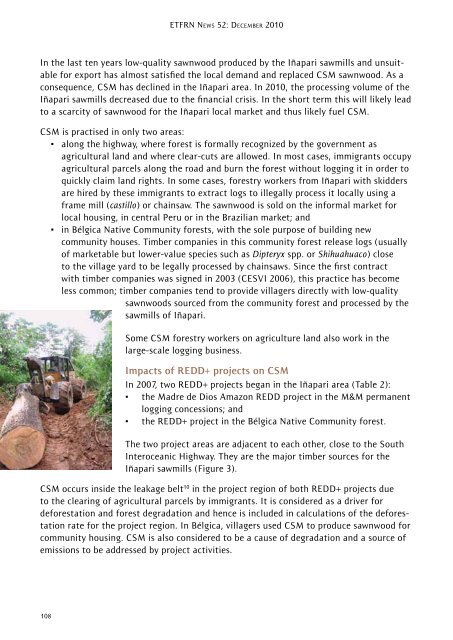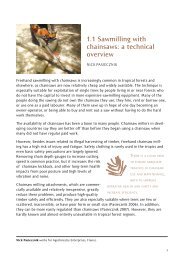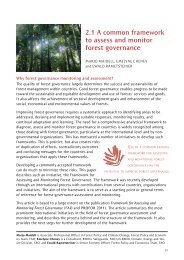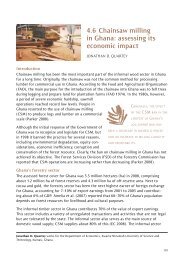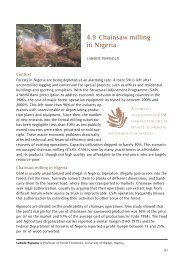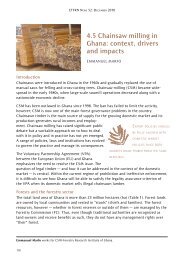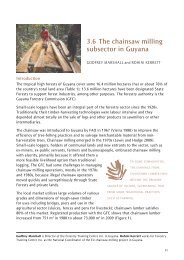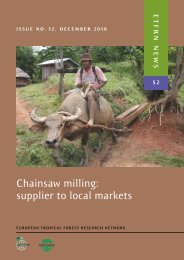Chainsaw milling: supplier to local markets - European Tropical ...
Chainsaw milling: supplier to local markets - European Tropical ...
Chainsaw milling: supplier to local markets - European Tropical ...
You also want an ePaper? Increase the reach of your titles
YUMPU automatically turns print PDFs into web optimized ePapers that Google loves.
108<br />
ETFRN NEws 52: DEcEmbER 2010<br />
in the last ten years low-quality sawnwood produced by the iñapari sawmills and unsuitable<br />
for export has almost satisfied the <strong>local</strong> demand and replaced Csm sawnwood. as a<br />
consequence, Csm has declined in the iñapari area. in 2010, the processing volume of the<br />
iñapari sawmills decreased due <strong>to</strong> the financial crisis. in the short term this will likely lead<br />
<strong>to</strong> a scarcity of sawnwood for the iñapari <strong>local</strong> market and thus likely fuel Csm.<br />
Csm is practised in only two areas:<br />
• along the highway, where forest is formally recognized by the government as<br />
agricultural land and where clear-cuts are allowed. in most cases, immigrants occupy<br />
agricultural parcels along the road and burn the forest without logging it in order <strong>to</strong><br />
quickly claim land rights. in some cases, forestry workers from iñapari with skidders<br />
are hired by these immigrants <strong>to</strong> extract logs <strong>to</strong> illegally process it <strong>local</strong>ly using a<br />
frame mill (castillo) or chainsaw. The sawnwood is sold on the informal market for<br />
<strong>local</strong> housing, in central peru or in the brazilian market; and<br />
• in bélgica native Community forests, with the sole purpose of building new<br />
community houses. Timber companies in this community forest release logs (usually<br />
of marketable but lower-value species such as Dipteryx spp. or Shihuahuaco) close<br />
<strong>to</strong> the village yard <strong>to</strong> be legally processed by chainsaws. since the first contract<br />
with timber companies was signed in 2003 (CEsVi 2006), this practice has become<br />
less common; timber companies tend <strong>to</strong> provide villagers directly with low-quality<br />
sawnwoods sourced from the community forest and processed by the<br />
sawmills of iñapari.<br />
some Csm forestry workers on agriculture land also work in the<br />
large-scale logging business.<br />
impacts of REDD+ projects on csM<br />
in 2007, two rEDD+ projects began in the iñapari area (Table 2):<br />
• the madre de Dios amazon rEDD project in the m&m permanent<br />
logging concessions; and<br />
• the rEDD+ project in the bélgica native Community forest.<br />
The two project areas are adjacent <strong>to</strong> each other, close <strong>to</strong> the south<br />
interoceanic highway. They are the major timber sources for the<br />
iñapari sawmills (Figure 3).<br />
Csm occurs inside the leakage belt 10 in the project region of both rEDD+ projects due<br />
<strong>to</strong> the clearing of agricultural parcels by immigrants. it is considered as a driver for<br />
deforestation and forest degradation and hence is included in calculations of the deforestation<br />
rate for the project region. in bélgica, villagers used Csm <strong>to</strong> produce sawnwood for<br />
community housing. Csm is also considered <strong>to</strong> be a cause of degradation and a source of<br />
emissions <strong>to</strong> be addressed by project activities.


